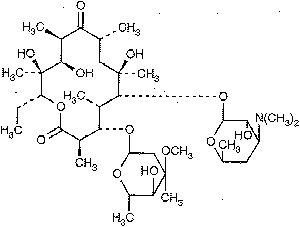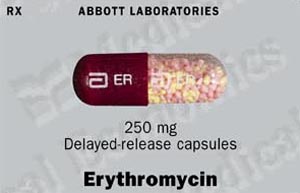 |
| Erythromycin |
| Introduction: Erythromycin is a prototype of Macrolide antibiotics with a primarily Bacteriostatic action against a broad range of bacteria (Gram positive <Gm's +ve> and to a lesser extent of Gram negative <Gm's -ve> as well as another organisms). These drugs inhibit the Ribosomal protein synthesis in bacteria and thus have a bacteriostatic and bactericidal effect. Erythromycin is used in conditions such as Diphtheria, Pertussis, Legionnaire's disease and other RTI (Respiratory Tract Infections) as well as being used as alternative to Penicillins in Penicillin-allergic patients and as an alternative to TCN (Tetracycline Antibiotics) in Chlamydial infections and some other conditions. It can be given by mouth, usually as its salt or esters, it can be also given Intavenously (IV). It is used topically in the treatment of neonatal conjunctivitis and acne. Adverese effects include Gastrointestinal disturbances, hepatotoxicity, transient deafnee and thrombophelebitis following IV administration. |
| Source and Trade Names: Source and History: Erythromycin was discovered in 1952. Originally obtained from a soil sample collected in the Philippine Archipelago. It is produced by the growth of a strain of Streptomyces erythreus and is a mixure of Macrolide Abs consisting largely of Erythromycin A. Trade Names: Generic Name: ERYTHROMYCIN Trade Names: (E.E.S.�, Ery-Tab�, Erythrocin�, PCE�, EryPed�, Ilosone�, Ilotycin�, Fougera�, Ocu-Mycin�, Akne-Mycin�, Staticin�, Erygel�, EryDerm�) |
| Mechanism of Action: 1. Its action is predominantly bacteriostatic but it may be bactericidal in high concentration or against highly susceptible organisms. 2. Erythromycin inhibits protein synthesis in susceptible organisms by binding reversibly to 50S ribosomal subunits, thereby inhibiting translocation or transpeptidation of amino acyl transfer-RNA and inhibiting polypeptide synthesis and hence inhibit bacterial growth. * Erythromycin exerts its effect only against multiplying organisms. Only un-ionized erythromycin is believed to penetrate suscepltible bacteria. Its actions are increased at moderately alkaline PH, particularly in Gm's -ve species, probably because of the improved cellular penetration of the non-ionized form of the drug. Generally, Erythromycin penetrates the cell wall of Gm's +ve bacteria more readily than that of Gm's -ve bacteria. |
| Mechanism of Resistance: Several mechanisms of acquired resistance to Erythromycin have been reported. 1. The most common is a Plasmid-mediated ability to methylate ribosomal RNA, decreasing binding of the antimicrobial agent. Because they share a common binding site on the ribosome, cross-resistance occurs in organisms with this type of resistance between erythromycin, other Macrolides, Lincosamides and Streptogramin B and this pattern of resistance is referred to as the MLSB phenotype. This type of resistance is seen in Staphylococci and to a somewhat lesser extent in Streptococci. 2. Decreased binding of antimicrobial agent to the ribosome may also occur as a result of a chromosomal mutation, resulting in an alteration of the ribosomal proteins in the 50S subunit, which conveys one-step high level erythromycin resistance. This form has been demonstrated in E-coli, some Streptococcus pyogenes and Staphylococcus aureus. 3. Other form may be due to the elaboration of a Plasmid-determined erythromycin esterase which can inactivate the drug, or to decreased drug penetration. This type has been shown in Gm's -ve bacteria like Enterobacteriaceae. * Enterobacteriaceae and Pseudomonas are usually resistant to erythromycin, as are viruses and fungi. |
| SAR: Erythromycin contains many membered lactone ring to which are attached one or more deoxy sugars. Structural modifications can take place in order to produce more stable and broaded spectrum drugs. Azithromycin, Clarithromycin and Dirithromycin are semisynthetic Macrolide ABs structurally and pharmacologically related to Erythromycin. 1. Azithromycin, an azalide, differs structurally from erythromycin by the addition of a methyl-substituted nitrogen atom into the lactone ring. |
 |
| 2. Clarithromycin differs from erythromycin only by the methylation of a hydroxyl group at the 6 position on the lactone ring. 3. Dirithromycin, structural differences compared to erythromycin are thought to result in improved GI tolerance, decreased potential to interact with other metabolites, improved tissue penetration and increased elimination half-life. 4. Troleandomycin is the acetylated ester of the macrolide AB oleandomycin and is structurally and pharmacologically related to erythromycin. These structural modifications improve acid stability and tissue penetration and broaden the spectrum of activity. |
| Spectrum: Erythromycin has a broad spectrum activity against a wide range of micro-organisms. 1. It is active in vitro against Gm's +ve cocci and Gm's +ve bacilli. It is also active in vitro against Gm's -ve cocci and some Gm's -ve bacilli. 2. It has some in vitro activity against Mycobacterium kanasii and Mycobacterium scorfulaceum. 3. It is active in vitro against Helicobacter pylori. However, in vivo efficacy of the drug against the organism has been poor, possibly as a result of inactivation of the drug by the stomach acid and/or the rapid development of resistance when erythromycin is used alone for H.pylori infection. Examples of Gm's +ve organisms sensitive to erythromycin: Bacillus anthracis, Corynebacterium diphtheria, Erysipelothrix rhusiopathiae and Listeria monocytogenes. Usually moderately effective against Clostridium Spp., Nocardia Spp. and effective againts Propionibacterium acnes. Examples of Gm's -ve cocci sensitive to erythromycin: Neisseria meningitidis, Neisseria gonorrhoeae and Moraxella catarrhalis. Other Gm's -ve organisms vary in their susceptibility but useful activity has been reported for Bordetella Spp, some Brucella strains, Flavobacterium, Legionella Spp., Pasterurella and Haemophilus ducreyi. Pneumococcal pneumonia normally respond well to erythromycin, Haemophilus influenzae, on the other hand, is often resistant. MIC (Minimum Inhibitory Concentration) May be as little as 0.001�g/ml for most sensitive strains of Streptococcus pneumoniae and Mycoplasma pneumoniae. MIC ranges from about 0.01 to 0.25�g/ml. Organisms with MICs up to about 0.5�g/ml are considered sensitive and those with MICs between about 0.5 and 2�g/ml of moderate sensitivity. |
| Uses: It is a bacteriostatic AB with a wide spectrum of activity which has been used in the treatment of a wide variety of infections caused by susceptible organisms. 1. Bronchitis. 2. Campylobacter enteritis. 3. Chancroid. 4. Diphtheria. 5. Legionnaire's disease. 6. Legionella infections --> * Erythromycin is the drug of choice *. 7. Neonatal conjunctivitis. 8. Pertussis. 9. Pneumonia. 10. Sinusitis. 11. Used as an alternative to penicillin in penicillin-allergic patients with various conditions including anthrax, syphilis, the prophylaxis of endocarditis, leptospirosis, otitis media and pharyngitis. Prevention from rheumatic fever and Staphylococcal and Streptococcal skin infections. 12. As an alternative to the TCN in patients with Chlamydial infections. 13. Pelvic inflammatory disease and in Tularaemia. 14. Severe Acne. 15. Streptococcal infections, mild to moderately severe infections of the (Lower and Upper) RT, skin and soft tissue caused by Streptococcus pyogenes (group A �-hemolytic Streptococci). 16. In Prophylaxis against �-hemolytic Streptococcal bacteria. 17. Haemophilus infections. 18. Spirochetal infections: (Lyme disease). 19. Chlamydial and Mycoplasmal infections. Not suitable for the treatment of Syphilis and Gonorrhea nor for the prophylaxis of endocarditis. |
| Pharmacokinetics: Absorption: Absorption of orally administered erythromycin occurs mainly in the duodenum. Gastric acidity causes partial inactivation of some of these drugs, with the degree of inactivation depending on the acid stability of the particular derivative and dosage form. Single oral doses of erythromycin generally produce peak serum concentrations within 1-4 hours. Distribution: Erythromycin is widely distributed into most tissues and fluids. Erythromycin crosses the placenta, achieving fetal serum concentrations 5-20% of maternal serum concentrations. Elimination: The serum half-life of erythromycin in patients with normal renal function is usually 1.5-2 hours, but may range from 0.8-3 hours. Metabolism: Erythromycin is partly metabolized in the liver by N-demethylation to inactive, unidentified metabolites. It is mainly excereted unchanged via bile. Some reabsorption follows biliary excretion, small amounts of erythromycin are also excreted in urine. Only small amounts of erythromycin are removed by hemodialysis. |
| Contraindications: Erythromycin is contraindicated in: 1. Patients with history of hypersensitivity reactions to the drug. 2. Patients receiving astemizole or trefenadine; since erythromycin may impair metabolism of the antihistamines, potentially resulting in serious cardiotoxicity. 3. Erythromycin estolate is contraindicated in pateints with hepatic dysfunction or pre-existing liver disease. 4. Other erythromycins should be used with caution in patients with impaired hepatic function or impaired biliary excretion. 5. Should never be prescribed with the following drugs because of the high risk of severe interactions: << Aastemizole, Carbazepine, Cisapride, Colchicine, Cyclosporine, Digoxin, Dihydroergotamine, Ergotamine, ABs like Grepofloxacin or Sparfloxacin, Oral contraceptives, Primozide, Terfenadine, Theophylline, Triazolam or Warfarine >>. |
| Rare/ Serious Side Effects: 1. Dark yellow or brown urine. 2. Dyspnea, (Dfficulty in breathing). 3. Deafness. 4. Ringing in the ears. 5. Severe or watery diarrhea. 6. Skin Rach Hives or Itching. 7. Swelling of face or neck. 8. Jaundice, (Yellowing of eyes or skin). 9. Hepatic dysfunction. 10. Local effects: venous irritation and thrombophlebitis have occured following IV administration of erythromycin glucepate or erythromycin lactobionate. 11. Cardiac effects: development of ventricular arrhythmias including atypical ventricular tachycardia. |
| Side Effects: |
| Expected/ Mild Side Effects: 1. Diarrhea. 2. Anorexia (Loss of appetite). 3. Nausea and Vomiting. 4. Gastrointestinal disturbances (dose related). 5. Pain or pounding to the chest. 6. Dizziness. |
| Preparations: Exists as oral tablets or capsules, suspention, injection, eye ointment, skin ointment, lotion or pledgets. * Erythromycin Acistrate. * Erythromycin Estolate. * Erythromycin Succinate. * Erythromycin Glucepate. * Erythromycin Lactobionate. * Erythromycin Stearate. * Erythromycin Propionate. |
 |
| References: 1. AHFS by Gerald K. Mcevoy. Pharm. D 2. Martindale by James E.F Reynold's 30th edition. 3. Goodman and Gilman the pharmacological basis of therapeutics by Hardman Limbird & Molinoff Ruddon Gilman. 4. Remington 5. BNF 6. Internet sites: www.medscape.com, www.yahoo.com, www.healthtouch.com, www.informed.org, www.healthanswers.com, www.healthsquare.com, www.cheshire-med.com, www.rxlist.com. |
By: SH.Y.O |